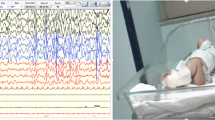Abstract
The technique of ABR testing was applied to 25 infants with neonatal hyperbilirubinemia at levels exceeding that for exchange transfusion, in an attempt to study potential influence of bilirubin toxicity on the auditory brainstem pathway. The test was performed at a mean conceptional age of 40.4 ± 0.6 weeks just after discharge. Twenty normal term neonates of comparable birth weights and conceptional ages, who had no hyperbilirubinemia, were also examined for comparison.
Fifty six percent (n = 14) of the hyperbilirubinemic neonates had, some abnormality in the ABR pattern, the major one being a transient increase in the threshold of wave V (7, fail-30; 5, fail-45). Wave V, however, was consistently present at 30 dBnHL click stimulus in all the normal neonates (pass 30; normal threshold). Further, mean ABR latencies (wave III, V) and 1-V interpeak latency (brainstem conduction time) were significantly prolonged in jaundiced neonates as compared with controls (P < 0.01). ABR changes were strongly correlated with the serum bilirubin levels (P < 0.001). On follow up retesting at 3 months, however, all infants were found to have normal ABR latencies and threshold. Neonatal jaundice was associated with significant transient aberrations pf ABR, suggestive of a transient toxic brainstem encephalopathy.
Similar content being viewed by others
References
Evans PR, Polani PE. The neurological sequaele of Rh sensitization.Q J Med 1950; 19: 129–149.
Dublin WB. Neurologic lesions of erythroblastosis fetalis in relation to nuclear deafness.Am J Clin Pathol 1951; 21: 935–939.
Crabtree N, Gerrard J. Perceptive deafness associated with severe neonatal jaundice.J Laryngol Otol 1950; 64: 482–506.
Belal A Jr. Effects of hyperbilirubinemia on the inner ear in Gunn rats.J Laryngol Otol 1975; 89: 259–265.
Picton TW, Taylor MJ, Durieux-Smith A, Edwards CG. Brainstem auditory evoked potentials in pediatrics. In: Aminoff MJ, ed.Electrodiagnosis in Clinical Neurology, 2nd ed, New York : Churchill Livingston, 1986: 505–534.
Perlman M, Fainmesser P, Sohmer H et al. Auditory nerve brainstem evoked responses in hyperbilirubinemic neonates.Pediatrics 1983; 72: 658–664.
Kaga K, Kitazumi E, Kodama K. Auditory brainstem responses of kernicterus infants.Int J Pediatr Otorhinolaryngol 1979; 1: 255–258.
Chisin R, Perlman M, Sohmer H. Cochlear and brainstem responses in hearing loss following neonatal hyperbilirubinemia.Ann Otol Rhinol Laryngol 1979; 88: 352–357.
American Academy of Pediatrics. Joint Committee on Infant Hearing: Position statement 1982.Pediatrics 1982; 70 : 496–497.
Cockington RA. A guide to the use of phototherapy in the management of neonatal hyperbilirubinemia.J Pediatr 1979; 95: 281–285.
Epstein CM. The use of brainstem auditory evoked potentials in the evaluation of the central nervous system.Neurol Clin 1988; 6: 771–789.
Despland P, Galambos R. The auditory brainstem response (ABR) is a useful diagnostic tool in intensive care nursery.Pediatr Res 1980; 14: 154–158.
Picton TW, Durieux-Smith A. Auditory evoked potentials in the assessment of hearing.Neurol Clin 1988; 6: 771–808.
Kramer SJ, Vertes DR, Condon M. Auditory brainstem responses and clinical follow up of high risk infants.Pediatrics 1989; 83: 385–392.
Dubowitz LMS, Dubowitz V, Goldberg C. Clinical assessment of gestational age in the newborn infant.J Pediatr 1970; 77: 1–10.
Nwaesei CG, Aerde JV, Boyden M, Perlman M. Changes in auditory brainstem responses in hyperbilirubinemic infants before and after exchange transfusion.Pediatrics 1984; 74: 800–803.
Devries LS, Lery S, Whitelaw AG, Dubowitz LMS. Relationship of serum bilirubin levels and hearing impairment in newborn infants.Early Hum Dev 1987; 15: 269–277.
Devries LS, Lery S, Dubowitz LMS. Relationship of serum bilirubin levels to ototoxicity and deafness in high risk low birth weight infants.Pediatrics 1985; 76: 351–354.
Author information
Authors and Affiliations
Rights and permissions
About this article
Cite this article
Gupta, A.K., Raj, H. & Anand, N.K. Auditory Brainstem Responses (ABR) in neonates with hyperbilirubinemia. Indian J Pediatr 57, 705–711 (1990). https://doi.org/10.1007/BF02728718
Issue Date:
DOI: https://doi.org/10.1007/BF02728718




